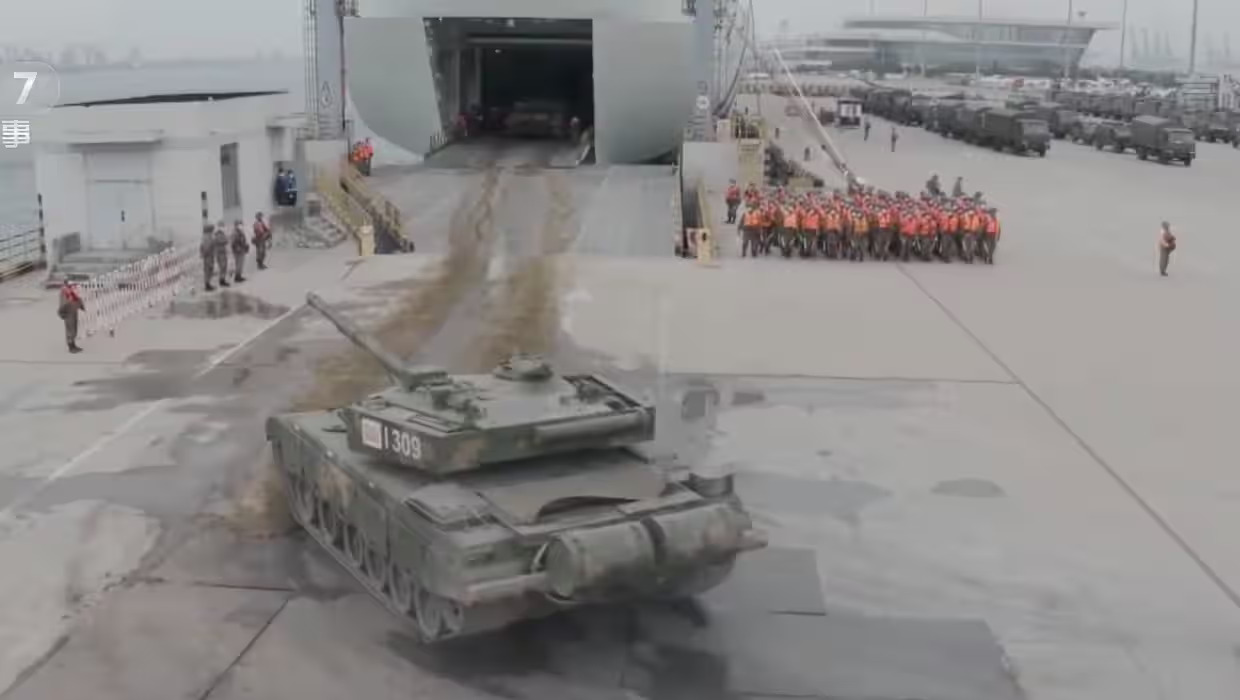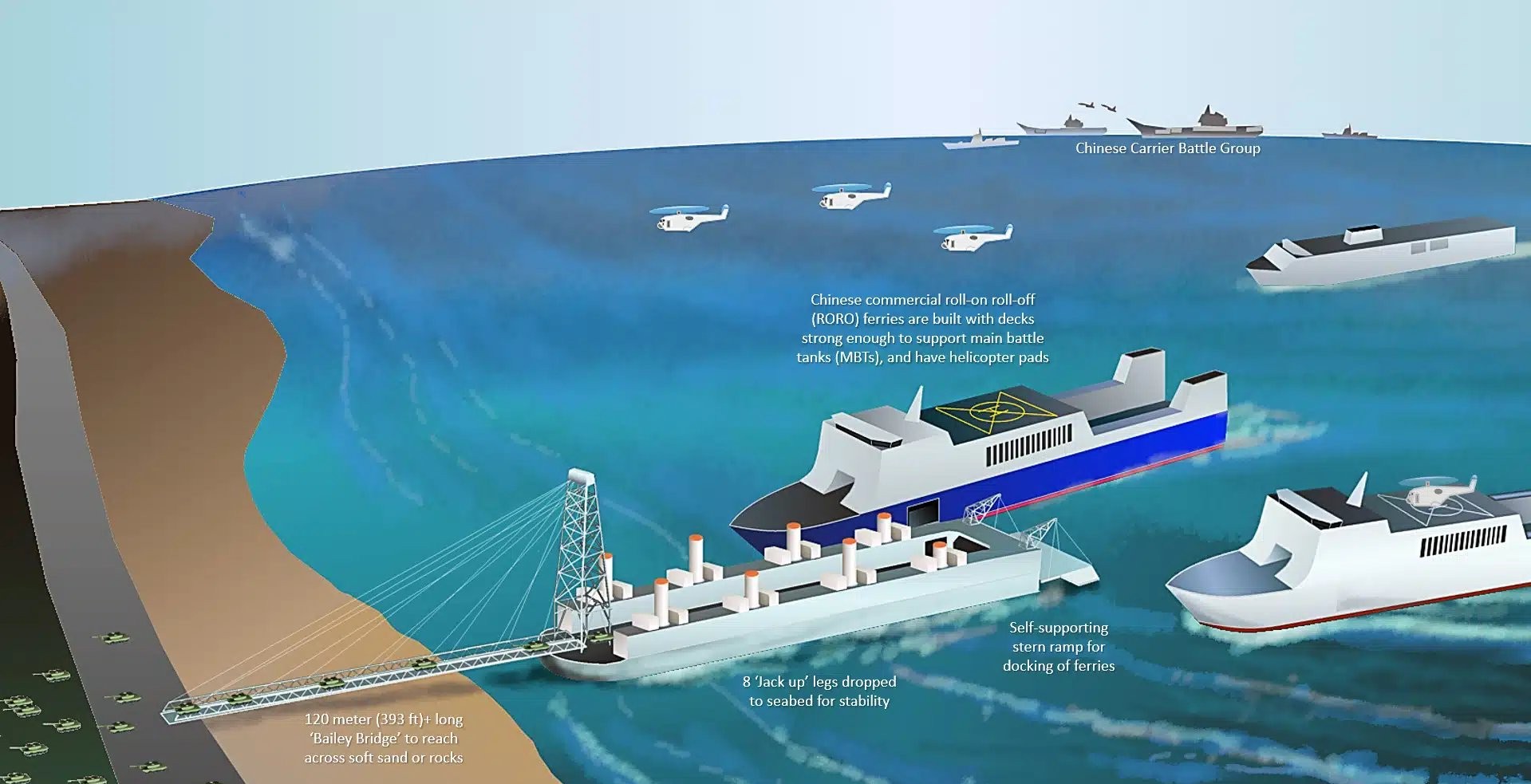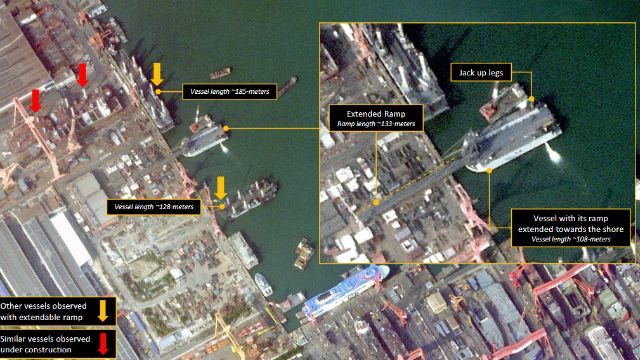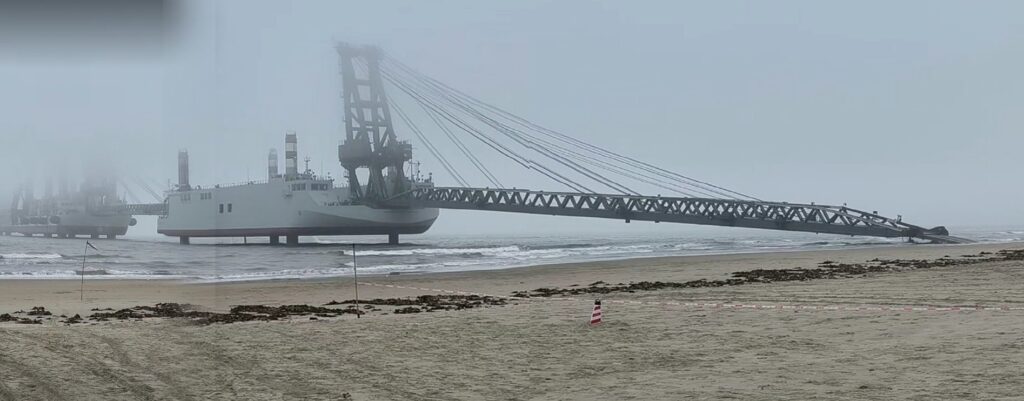The recent developments in China’s military infrastructure have revealed a new class of interconnected jack-up barges, designed specifically for large-scale troop and heavy equipment deployment has created a discussion on their potential role in a Taiwan invasion. These barges are spotted in the exercise near a key naval base in the South China Sea raising concerns about China’s strategic intentions, particularly regarding Taiwan. These barges are designed to create temporary piers on the seashore, which could rapidly offload troops, tanks and supplies onto Taiwan’s shores. This study analyses these barges’s technical aspects, operational feasibility, and geopolitical implications.
Introduction:
As tensions rise in the Taiwan Strait, China’s military modernisation efforts remain in the limelight. The most recent of these efforts is the creation of connected jack-up barges, which are intended to act as makeshift piers during amphibious landings. Barges might be a game-changer by allowing the People’s Liberation Army Navy (PLAN) to bypass heavily defended coastlines. In reality, the barges might face several challenges, including vulnerability to attack, unfavourable weather conditions, logistics issues, and strategic signalling that may backfire.

How do the Barges Work?
Unlike standard amphibious landing vehicles, these barges have a notable jack-up system, with cylinder legs to anchor them to the seabed. This provides a stable platform for offloading of tanks and other military vehicles. These jack-up barges are reported to be under construction at Guangzhou Shipyard International (GSI). The features of the jack-up barges include, long ramps exceeding 120 meters and stabilizing legs to anchor them to the seabed, the barges appear to work in tandem, with different types interconnecting to form a makeshift pier, and vehicles transfer from ferries at the back of the barge and drive through a bridge-like structure to reach dry land from sea.
These facilities can be utilized to link bigger ships, such as civilian roll-on/roll-off ferries adapted for military purposes, to coastal areas. This method is in line with the civil-military fusion approach adopted by China to utilize commercial infrastructure for military purposes. The capability to set up temporary installation facilities in non-traditional landing beaches can expand the invading options for China. Taiwan’s western coast only offers a limited number of potential beaches, many of which are well fortified with anti-landing defenses, mines, and artillery positions.

Significance of the Barges:
The installations of these barges in the South China Sea would significantly enhance China’s military strength by allowing for rapid and large-scale deployment of armoured troops. These jack-up barges are capable of bypassing the limitation placed by hovercraft which could transport only one tank at one trip. These barges’s functional ability to provide strategic beach landing enables the delivery of heavy machinery even on non-traditional and unknown beaches, this ability helps China to increase its amphibious assault capability. Additionally, these barges provide greater flexibility in different types of coastal terrain by removing the necessity for safe harbours or specified landing sites, thus improving operational flexibility in different combat scenarios.
Strategic Intentions Behind the Barges:
China’s development of these specialized landing barges is a key component of its overall military strategy, particularly in the case of a war with Taiwan. The ability of China to bring armoured troops and large formations rapidly onto Taiwan’s shores is a primary element of any invasion strategy. Recent exercises in one of China’s bases in the South China Sea, which is the home to China’s amphibious forces suggest that such barges are being tested and refined to enhance operation effectiveness.
Among the most important aspects of China’s strategy is its unique way of designing ferries and barges, specifically its ability to carry tanks and other heavy military equipment. This aligns with its broader goal of maximizing force projection capabilities in maritime conflict zones. Unlike traditional ferry construction practices of other nations, which are focused on civilian transportation, China’s focus on military flexibility is a reflection of its extensive planning in the context of future amphibious warfare.
Satellite Image of Possible Amphibious Operations Support Vessels, Guangzhou, China Image Source: AllSource Analysis
Key Challenges and Limitations:
China’s landing barges are highly exposed and would risk losing their operational effectiveness in the case of an invasion of Taiwan. Once the barges are deployed they become easier targets for Taiwan’s advanced anti-ship missiles like the Hsiung Feng III, and possible intervention by the United States, Japan, or Australia further reduces their effectiveness. The immobility of Barges i.e. stationary nature makes them highly vulnerable to attack, and the unpredictable weather conditions of the Taiwan environment like frequent typhoons, strong currents, and rough coastlines add more risk to it.
Besides environmental and tactical threats, logistical challenges could also disrupt the functioning of barges. In case Taiwan attacks the ferries before they reach port or if they interfere with offloading, China’s invasion plans could be thwarted. These barges could be employed for follow-on forces and can make their success dependent on early air and naval dominance. The barge development has already provoked defensive measures from Taiwan and its allies and could diminish the strategic advantage. Increased military readiness, economic sanctions, and diplomatic expenses will ultimately turn these barges into liabilities rather than assets in a prolonged conflict.
Conclusion:
The deployment of amphibious landing barges is a major development in China’s military capabilities, especially in the context of its possible conflict with Taiwan. Although these barges facilitate rapid deployment of troops and equipment, their overall utility is questionable due to several vulnerabilities like missile attacks, harsh maritime conditions, and logistical challenges. Furthermore, these barges could raise concerns beyond Taiwan, which can affect the regional security dynamics. Overall, although these barges are a reflection of China’s expanding military ambitions, they can also provoke countermeasures that alter the existing balance of power in the Indo-Pacific.

